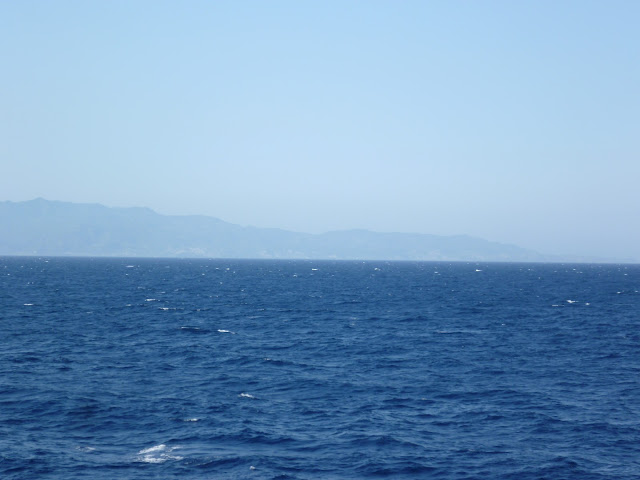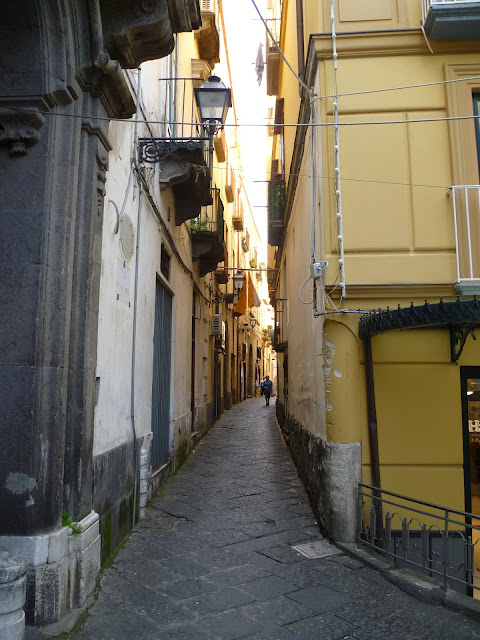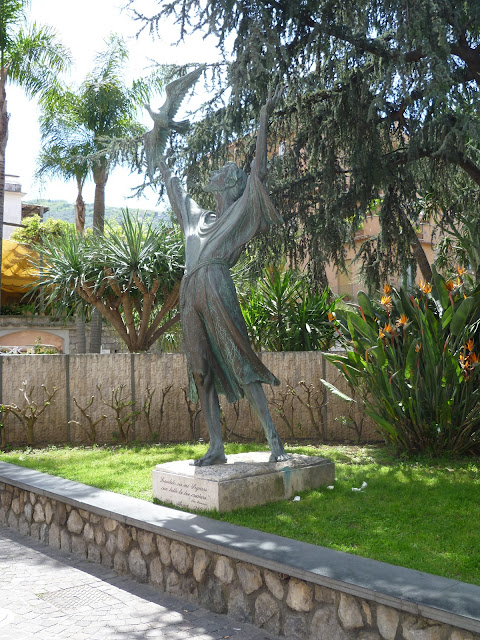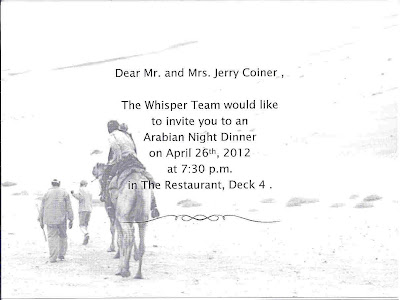Prepared September 16, 2012 at home Kona, Hawaii
April 16 to 20 at Sea: Gulf of Oman, Arabian Sea, Gulf of Aden and Red Sea.
M/V Silver Whisper departed the port of Muscat at 5:00pm local time on April 15 and set course for the Red Sea port of Safaga, Egypt. This was five and one-half days of sailing near the coasts of eight countries none of which, with the possible exception of Saudi Arabia and Oman, were more than two arms dealers away from an uprising of some sort. So, it was full nighttime security, and a high level of novel rumors.
Destination Safaga, Egypt
Since Joann and Danny, our favorite bridge instructors, had left the cruise in Singapore, and we had been off-ship in Viet Nam, our bridge playing skills were rapidly atrophying. We saw little hope of them ever improving (old dog, new tricks -- that sort of thing); therefore, we decided to attend the ship's enrichment lectures instead of providing the dog's tail for contract bridge. The lectures that were of particular interest to us were on ancient Egypt and were presented by Prof. Bob Brier and Patricia Remler over the five sea days. They covered numerous topics of archaeology and ancient history, including mummification, Egyptian historiography, Tutankhamen, Hatshepsut, the temples of Karnak and Luxor, Egyptian mythology, the Great Pyramid, Cleopatra, and Napoleon in Egypt. All-in-all, a good introduction to Ancient Egypt.
April 21 and 22 in port Safaga, Egypt: Welcome, First Tourist of 2012!
We docked in Safaga at 7:00am, and the vast majority of passengers departed by bus for an overnight tour of the Karnak/Luxor temples and the Valley of the Kings. J and E decided that two,150-mile bus rides through the Eastern Egyptian desert to see heavily-touristed attractions (which we had already seen several times) were not in the cards for this trip. So, we stayed on board in Safaga.
The port of Safaga's main purpose is to allow Egyptian workers and pilgrims access to Saudi Arabia. Everyday, two or more large ferries depart and arrive from the Saudi port of Jeddah.
Ferry Across the Red Sea
Safaga/Jeddah ferry embarking passengers and cargo.
The previous Egyptian government had made some attempt to develop tourist facilities at Safaga, and Silversea provided a shuttle bus for the 15-minute trip from the port to the tourist area. J and E decided to take the shuttle bus (15 minutes is just tolerable) to the Riviera Abu Soma Hotel in the tourist zone, so E could buy a dress for the upcoming Arab dress night. Armed with a locally-produced tourist map, we stepped off the bus and found we were in the middle of a ghost town with only our few fellow passengers to be seen and even fewer Egyptians. There was no need for the tourist map -- only a single paved street.
Welcome to Safaga
Be very careful crossing the street!
The economic impact of the Arab Spring was obvious from empty hotels and streets and abandoned construction sites. The price of freedom, as so many have found, is often starvation. Numerous gift, curio and tourist-activity related shops were open, but almost everything was covered with a coat of fine sand. Nothing was happening here.
This Is NOT the Entrance to Tut's Tomb
Papyrus painting of Tutankhamen's gold funerary mask on local shop door
We looked in several shops and finally found a dress shop where E purchased a local-style dress -- mumu with excessive, fancy embroidery. The dress selection process took about 45 minutes, with the display of at least 30 different dresses! J's haggling over the price then took another 30 minutes, with two near departures from the store. The merchant still won, but J only overpaid by half again! Some sort of victory. And, given the state of the local economy, we didn't feel too put upon.
After the purchase, we finished our promenade, carefully crossed the street, and returned to the hotel lobby, which was our collecting point for the shuttle bus back to the port. The rest of the day was spent eating, writing the blog, and visiting with others who didn't go to Luxor. That evening was a special buffet in the Terrazza.
Next day in port we spent on board, and after the return of those passengers from their tour to the Nile valley, we sailed for Aqaba, Jordan.
Goodbye Safaga!
Sunset over Safaga and the Eastern Desert.
April 23 in port Aqaba, Jordan: "On to Aqaba"
We docked at the port of Aqaba, Jordan at 7:30am. Most of the passengers disembarked for a long day of bus trips to visit the Nabatean city of Petra about 60 miles north of Aqaba, or to Wadi Rum. We decided that since we had been to Petra and were not terribly interested in a large sand pile surrounded by cliffs, we would stay in Aqaba and visit the Aqaba museum in the Mamluk (Turkish) fort. After the battle of Aqaba (July 6, 1917), this fort was surrendered by the Turks to Auda ibn Tayi, T. E. Lawrence, and Emir Faisal's Arab army. Aqaba then became a major British supply base for Faisal's campaign against the Turks in Arabia and Palestine.
A historical side note: During the fighting around Aqaba, Col. T. E. Lawrence, while involved in an assault on Turkish troops, shot his own camel in the head and killed it. Luckily, the camel did not fall on him and he was unhurt. I don't think this was in the Victoria Cross commendation or the movie, "Lawrence of Arabia."
Aqaba is located at the northern end of the Gulf of Aqaba. Four Middle Eastern countries converge at this point -- Egypt, Israel, Jordan, and Saudi Arabia. From our ship's observation lounge, you can see all four countries.
After breakfast, we took the shuttle bus into the Tourist Information Center, collected directions and a map to the fort (known locally as the Aqaba Castle or Mamluk Fort), and had a leisurely walk along an embankment above the park which borders the shore line.
Aqaba Shorline Park
The park is oasis-like, with paddy rice and date palms.
We also saw one of the few remaining early Turkish-period stone buildings, which were probably merchant houses and godowns close to the port.
Pre-WWI Turkish Merchant's House
Aqaba was a focus for trade between the Middle East and the Orient.
Mamluk Fort, Landward Entrance (Partially Restored)
During the Battle of Aqaba, not a great deal of fighting occurred here.
The garrison surrendered with little resistance.
Seaward Entrance, Built by British During WWI
Eloise playing honor guard.
British Built Supply Depot w/ Mumluk Fort in Background
Museum exhibits were on right and offices, etc. on left.
After about 30-minutes walking, we reached the fort/museum, purchased Admission Tickets, and began to wander around viewing the exhibits. Parts of the Mumluk Fort date to the 12th Century, when a fort was originally built on the site by the Crusaders. It was rebuilt as it now appears in the 14th Century by the Mumluk's and added onto by the British, when it became a supply depot during WWI.
The Official Admission Ticket
It only took about 15 minutes to find someone to sell us one.
The Aqaba area has been inhabited since pre-historic times, and the exhibits in the museum draw heavily on materials collected from archaeological expeditions to the area.
Artifacts from Archaeological Digs
The plate and pottery shards on the right are Chinese Celadon from the Yuan Dynasty.
Roman Altar 1st Century BCE
Yes, that unruly crowd in their short skirts were here, too!
After viewing the exhibits, which are mainly housed in the British-built part of the fort, we walked over to the Mumluk fort portion of the museum and were admitted by a young man, who volunteered to show us "some interesting stuff." He took us through the fort's entrance to see the courtyard with the well and into the death chamber, where Turks tortured and hung Arab revolutionaries. Also, up some very problematic stairs to the rampart positions. By the time he had finished his tour, there were about six of us. To this day, we don't know if he worked for the museum or was just free lancing for tips. He got one from us.
Mumluk Fort Entrance
The white plastic chair will be an artifact in 3,000CE.
Guard Post in Entrance Hall
A small example of Arabic calligraphy on the hall's walls.
Exterior of Prison Cells
Many went in, few came out.
Interior View, Fortress Courtyard and Walls
Remnant of the Hanging Post
Interior of room where prisoners where tortured and hanged.
Rifleman's (Archers?) Firing Slot on Rampart
This is in a very early section of the wall.
After leaving the fort, we started to walk back to the Tourist Information Center along the main street. We again passed the Al-Sharif Al-Hussein bin Ali Mosque, dedicated to the grandfather of the current King of Jordan. It is a very pleasing structure to look at, and we had intended to visit it on our return from the fort. However; because a service was being conducted in the Mosque, non-believers were not allowed on the grounds, so we had to forego touring the gardens and the mosque itself.
Al-Sharif Al-Hussein bin Ali Mosque
The white walls and dome almost sparkle in the bright sunlight.
Minaret, Al-Sharif Al-Hussein bin Ali Mosque
No one climbs up there. It is all electronic with big speakers.
Returning to the Tourist Information Center, we found the Silversea shuttle bus and boarded it to wait in air-conditioned comfort for the short trip back to the port.
After a lunch on deck at the pool grill (J got his weekly cheeseburger), we had a long afternoon nap, played cards (Eloise won, as usual!), we sailed down the Gulf of Aqaba for Sharm El Sheik, Egypt.
April 24 in port Sharm el Sheikh, Egypt: "Where Have All the Tourists Gone?"
Silver Whisper docked at 6:00am in the port of Sharm el Sheikh. J & E slept through this momentous event, but the more bright-eyed, bushy-tailed, religiously-driven cruisers were already on the pier at 6:30am for the 3-hour (150 miles), one-way, mother-of-all-tour-bus rides to Mt. Sinai and St. Catherine's Monastery in the middle of the Sinai Peninsula (see map).
We had made this pilgrimage once. Since we had no desire to climb Mt. Sinai on our knees, visit the site and living plant of the burning bush, or again see the fortress monastery built by the Roman Emperors Constantine and Justinian for twenty minutes (hurry, hurry or you will miss the bus back to ship), we decided to stay aboard, have a leisurely breakfast, and take a late-morning shuttle to Na'ama Bay.
Welcome to Sharm el-Sheikh
First person to see any living vegetation wins a prize.
Sharm el-Sheikh is one of those sand, sun, and water places you might find in South Florida or the Mexican Riviera. You expect those tourist destinations to be full of obscenely-behaving college students, loud music, and bad food. All the infrastructure for Western-style tourism is here in Sharm el-Sheikh, including the usual suspects, Hilton, Marriott, Hyatt Regency, ad infinitum. This was intended to be a destination resort on the Waikiki scale. There was only one problem, no tourists. On the 1-mile, shuttle-bus ride into town, you could count the cars on the road on your fingers. When we arrived at the pedestrian street in Na'ama Bay, there were just large numbers of small tourist shop owners, and the 20 or so of us from the ship (shop owners out-numbered tourists by about 20 to 1). Sometimes the "build it and they will come" theory of development does not work out so well! Of course, this tourism disaster was at least partly the result of the Arab Spring and the fall of the Mubarak regime, but one drive through the area and it screamed "over developed."

Na'ama Bay Pedestrian Street
It's hard to run a sun and sea resort without drunken college students!
Greetings from the Pharaoh
Tacky copies of ancient Egyptian artifacts are everywhere.
We walked down the promenade looking in the shops and finding the same endless Egyptian stuff that you see everywhere in Egypt. One of our friends, Max, bought a fez, and J bought some lose herbal tea, but there was nothing much being sold.
Our Friend, Max, Buys A Fez
Fezzes are rarely seen in the Middle East these days. They have been replaced by AK-47s.
A Herd of Stuffed Camels and Bedouin Drums
A stuffed camel herd is the best kind -- don't eat, spit, or bite.
Spice and Tea Shop, Loose Bedouin Tea in Center
J's Bedouin tea purchase was lost on the trip back to the ship. Probably just as well.
After passing an hour or so walking along the promenade and in and out of the tourist shops, we headed back for the return trip to the port. When we got to the bus, several of us asked the driver/guide if we could see Mubarak's estate (where he was interned at the time). He was very reluctant and evaded the issue. We never got to see the only really interesting thing in Sharm el-Sheikh!
The Gods of Egypt Bid You Farewell to Sharm el-Sheikh
Good thing the ancient Egyptians had many gods. What would the modern Egyptians sell?
So, we returned to the port, with the bus driver pointing out the International Peace Park and two casinos along the way. Back on board, we had lunch (never miss a meal!), naps, and played cards until sail-away at 3:00pm. An early departure was required for us to be in position at Suez (the southern entrance to the Suez Canal) for our north-bound convoy, which was transiting the Canal the next day.

























.jpg)
















































